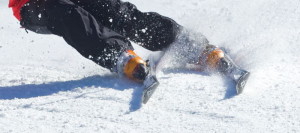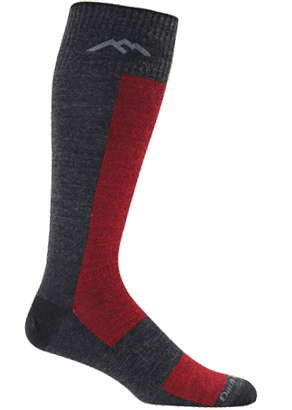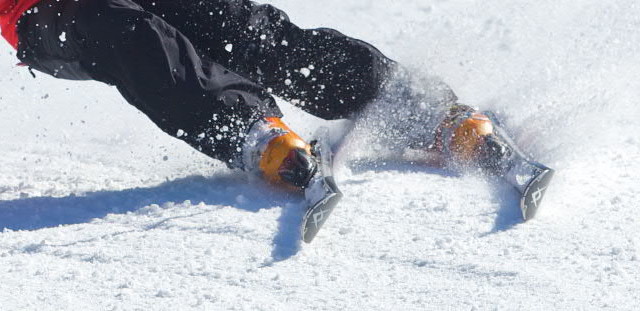
Boots are the single most important piece of the skiing puzzle. With the wrong boots or the wrong size boots, even the best ski won’t turn. With the right boots, any ski works fairly well and the best skis sing.
Choosing boots is a nightmare: myriad options, meaningless descriptions, flashy colors and advertising, no chance to try before you buy, and some very high prices; it’s easy to end up walking out of the store with the wrong boots–and that means your lift ticket money is going down the drain.
Here are some tips from our own explorations into choosing boots:
1. Pick The Right Ski Boots: Start from what you know
If you’ve already got boots, take them with you to the store and do a direct comparison. You already know what you like and don’t like about your old boots, so put one on one foot and a new boot on the other. Buckle both down, then compare. How does the flex feel? Does your heel move? Does the new boot do the things you like about your old boots as well or better…and not do the things you didn’t like? Make sure your new boots hold your foot tight.
Always take your own ski socks; a quality sock from Darn Tough, Smartwool, or Thor-Lo, for instance, will last longer and fit better than a cheapie, and will help your boots continue to fit right. If you use the same socks consistently, your boots will always fit right.

2. Pick The Right Ski Boots: Know yourself
Bode Miller’s favorite downhill boot may look hot, but if you’re a freeskier, they’ll make you miserable. A stiff plug boot is great if you like to race on steep, icy downhills, but excruciatingly painful for recreational skiing. Know your own skiing style, and then read the manufacturer’s literature for clues as to what THEY think is the best boot for that style, then start with those. Don’t let advertising overcome common sense.
3. Pick The Right Ski Boots: Mine’s stiffer than yours…or not?
Manufacturers like to put numbers on their boots…and guess what? They are only comparisons to other boots in that line, not rating on an absolute scale. 105 in one brand could be 90 in another. So, that number is just a general guide. Plus, it only relates to forward flex, not lateral stiffness. So, worry less about the number and more about how the boots feel on you.
Step on a scale (sorry!). If you weigh 240, you need a stiffer boot than if you weigh 140 and vice versa. Hint: most people choose boots that are way too stiff. Stiff boots are a holdover from racing on straight skis. And boots are stiffer when it’s cold, so if the boot feels stiff in the store, it’ll be too stiff on the slopes. Shaped skis need lateral stiffness; you don’t need to pressure the tips to get them to turn. With shaped skis you want your boot to work with the ski, not against it. Be honest with yourself. Most people don’t hammer steep ice that much, so don’t buy a stiff boot for the 5% of the time that you do it; choose something that works with the skiing you typically enjoy.
4. Pick The Right Ski Boots: Three things matter: Fit, Fit, And FIT!!!
I’ve been on a quest for better boots and will detail that in another story. But the single most important lesson is that fit trumps everything else. Any boot that fits you perfectly will outperform the “best” boot on the market that doesn’t fit, period.
The right boot fits VERY snugly around your entire foot and ankle without buckling the boot. Unless you are pushing hard, you can ski surprisingly well with your boots unbuckled–if they fit correctly.
Use a THIN sock, like the ones in the links above. A boot that fits correctly with a thin sock won’t have to be buckled down as hard to control the ski, which means more blood flowing to your toes, which means you’re warmer with a thin sock and a snug boot than you are with a larger boot and a thick socks. Counterintuitive, but true. And you’ll ski better, as a thin sock won’t allow your foot to move around in the boot.
5. Pick The Right Ski Boots: Fit by shell size, then by feel.
At least 75% of the skiers on any hill are in boots that are anywhere from a half size to two sizes too large for them. That’s because a boot that actually fits feels much too small in the store. And your feet shrink when it’s cold…like on the slopes. Think small.
If the shell’s too big, you’ve lost before you start. Shells can be expanded to allow for your foot shape, but they can’t be made smaller. When you’re about to try on a boot, first pull out the liner, put your insole back into the shell and put your foot inside. With your toes firmly touching the front of the shell, you should be able to slide a pencil (about 3/8-inch) down between your heel and the back of shell–and not much more. If there’s room for 2 pencils (3/4-inch) down there, try the next shell size smaller. If that one is too small for the pencil test, move on to another brand!
6. Pick The Right Ski Boots: Try a moldable or foamed liner
The “best” boot with a standard liner can’t fit you as well as a boot with a liner that is molded to YOUR foot and ankle. You simply can’t imagine (until you try it) how much this will improve your skiing. Better to buy a “lesser” boot with a formable liner than a “better” boot with a conventional one.
7. Pick The Right Ski Boots: Work with a boot fitter
The best boot and even the best liner on the planet can’t make up fully for little variations in your body. If one leg is 1/8 inch longer than the other, it will affect your skiing. If you pronate or supinate 1/2 degree, it’ll change how quickly your edges engage when you initiate a turn. That’s where a bootfitter comes in. Ideally, choose your bootfitter before you go boot shopping; let him/her recommend brands and models that are likely to fit you best.
Years ago, I was lucky enough to ski with World Cup racer Harald Harb when he was rolling out his new instruction system. He skied behind me, then stopped me and put a 1 degree wedge under my right boot and a 1/2 degree under my left boot…and changed my skiing forever. I then went to Paul Richelson of Feet First, one of the top bootfitters in America, and he fitted me with custom insoles and liners. Wow. Black diamonds started to feel like blue squares instantaneously! Seriously, having your skis flat and perfectly aligned makes good technique easy, and that’s done by the boot, not by the ski or binding. If you already have your boots, there’s still one more step you can take, and that’s a stance alignment; it can take your new high-tech boots and your skiing to entirely different levels!
If you follow the steps above, I can’t guarantee that you’ll find the perfect boot the first time…but you will come a lot closer to it than if you just go into a store, look at the blingy boots and pick one because it looks cool. Happy skiing!



[…] those of you who read “Ski Boots 101“, this is a longer article that discusses the process in greater detail. If you’re […]
[…] for you and hurting your skiing. For somequick thoughts on getting the right ski boots for you, go here; or if you want more in-depth information, go […]